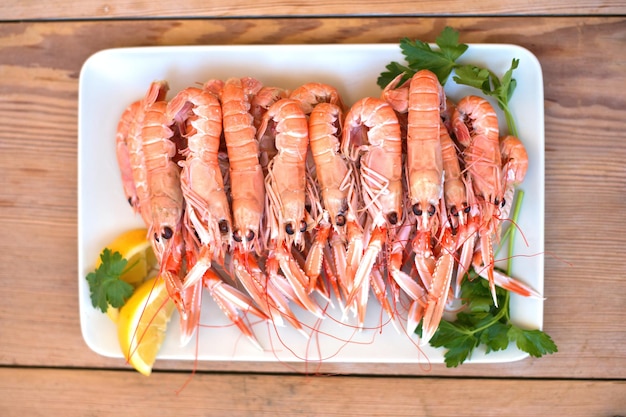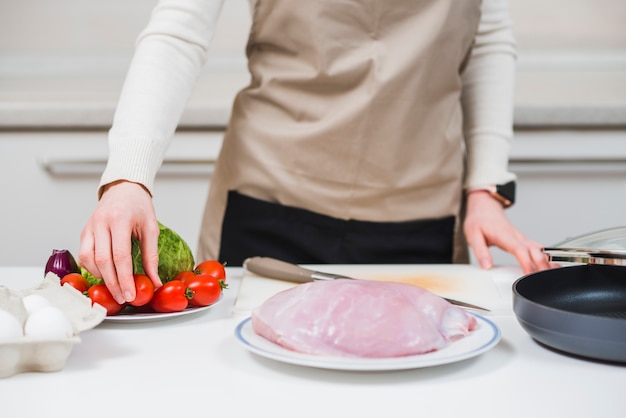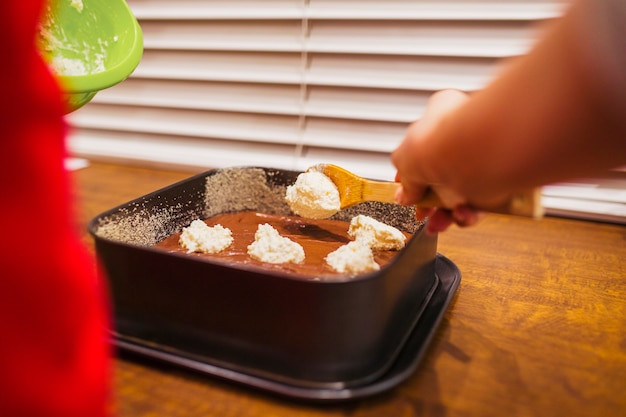Forget everything you thought you knew about burgers. We're going to ditch the gas grill and embrace the magic of cast iron. I'm talking about those burgers that come off the pan with a perfect sear, juicy and bursting with flavour, the kind that makes your mouth water just thinking about it. Trust me, once you've tasted a burger cooked in a cast iron skillet, there's no going back.
I've been obsessed with burgers for as long as I can remember. I've experimented with countless patties, toppings, and cooking methods. But the real game-changer came when I discovered the power of cast iron. It's a love affair that's been going strong for years, and I'm here to share my secrets, my tips, and my passion for achieving cast iron burger nirvana.
So, grab your apron, put on your favourite playlist, and get ready for a burger journey that will redefine your culinary horizons.
(Part 1) - Your Cast Iron Companion: Choosing the Right Skillet

Before we even think about patties and toppings, we need to talk about the star of the show: your cast iron skillet. It's not just a pan; it's an investment, a tool that will become your trusted culinary companion. So, let's choose wisely.
Size Matters: Finding the Perfect Fit
First things first, size matters. You don't want a skillet that's too small, or you'll be flipping burgers like a contortionist, risking sticking and a lot of frustration. But you also don't want a skillet that's so large that your burgers feel lost in a vast sea of cast iron. A 10-inch or 12-inch skillet is a great starting point for most home cooks. It's big enough to handle a couple of burgers without feeling crowded, but not so big that it becomes unwieldy.
Seasoning Your Skillet: The Magic Touch
Now, let's talk about seasoning. Seasoning is all about building a protective layer on the surface of your skillet, a layer of polymerized oil that prevents rust and creates that legendary non-stick surface that cast iron is famous for. It's a process that takes a little time and effort, but it's worth it, trust me.
Here's my go-to seasoning method:
- Clean Thoroughly: Give your skillet a good scrub with hot soapy water, making sure to remove any lingering residue.
- Dry Completely: Get that skillet bone dry. Moisture is the enemy of a well-seasoned cast iron.
- Apply a Thin Coat of Oil: Grab your favourite cooking oil, preferably grapeseed or canola oil (they have higher smoke points), and gently coat the entire surface of the skillet. Avoid olive oil, it's delicious but has a lower smoke point and can burn easily.
- Oven Time: Place your oiled skillet in an oven preheated to 350°F (175°C) for a full hour. This is where the magic happens, allowing the oil to polymerize and create that protective layer.
- Cool Down Slowly: Let the skillet cool completely in the oven. No rushing!
With each use, the seasoning will build up, making your skillet even more fantastic at cooking, a testament to the love and care you've invested in it. Think of it as a culinary heirloom, passed down through generations of burger-loving families.
(Part 2) - Crafting the Perfect Patty: A Culinary Symphony

Alright, we've got our cast iron ready, now let's talk about the soul of the burger, the patty itself. This is where the real artistry begins, where flavour and texture come together in a culinary symphony.
Choosing the Right Meat: A Matter of Fat and Flavor
When it comes to burger meat, there's a reason why a blend of 80% lean ground beef and 20% fat reigns supreme. The fat adds that incredible juiciness and flavour that makes a burger truly special. It's all about balance. Too lean, and you're risking a dry, tough patty.
When you're at the butcher, choose bright red, firm ground beef. Avoid anything that looks grayish, it's a sign that it's not as fresh as it could be.
Shaping the Patty: A Simple Guide
Now, let's shape our patties. I recommend a thickness of about 1/2-inch and a diameter of 4 inches. This size is the sweet spot for achieving a fantastic char on the outside while keeping the inside perfectly juicy. Smaller patties will cook faster, so adjust accordingly if you prefer a smaller burger.
Here's a little secret: avoid pressing down on the patty while it cooks. It's tempting, but it will only squeeze out those precious juices, leaving you with a dry burger. Just let it cook undisturbed, and it will do its magic.
For the perfect patty, follow these tips:
- Gentle Handling: Don't overwork the meat. Just gently mix it together, no kneading or over-mixing.
- The Well: Create a shallow well in the center of each patty. This little trick helps the patty cook evenly. As the patty cooks, the center will bulge up, which is perfectly normal. Just make sure your well isn't too deep.
- Chill Out: Refrigerate the patties for 30 minutes before cooking. This will help them hold their shape and prevent them from shrinking while they cook, making them easier to handle.
(Part 3) - Mastering the Cast Iron Cook: The Sizzle of Perfection

The cast iron is prepped, the patties are ready. Now, it's time for the grand finale, the cooking! Get ready for a sizzling symphony of flavour.
Preheating: The Key to a Perfect Crust
The secret to a perfectly cooked burger is a screaming hot skillet. Before you even think about adding those beautiful patties, get that cast iron blazing hot. Place it on the stove over medium-high heat and let it heat up for 5-7 minutes. You'll know it's ready when a drop of water sizzles and evaporates instantly upon contact. This is where the magic of cast iron really shines.
Cooking the Patties: Patience is Key
Gently place your patties in the hot skillet. You'll hear that satisfying sizzle, a sign that things are about to get delicious. Resist the urge to flip them immediately. Let them cook undisturbed for 3-4 minutes per side, allowing them to develop that beautiful, crusty exterior. You'll know they're ready when they're firm to the touch and slightly browned around the edges.
Flipping Time: A Gentle Touch
After those precious 3-4 minutes, it's time to flip. Don't be afraid to give them a gentle nudge to get them moving. If they stick, let them cook for a few more seconds and try again. That crusty exterior will help them release from the pan. Cook the other side for another 3-4 minutes, or until they're cooked to your liking.
For medium-rare, aim for an internal temperature of 130°F (54°C). For medium, cook to 140°F (60°C). And for well-done, cook to 160°F (71°C). You can use a meat thermometer for accuracy, but with a little experience, you'll be able to judge the doneness just by looking and feeling the patty.
Adding Flavor: The Finishing Touches
While those patties are sizzling away, let's add some flavour. A sprinkle of salt and pepper is a classic must, but don't be afraid to experiment with other seasonings like garlic powder, onion powder, or paprika.
For an extra touch of indulgence, try adding a dollop of butter to the skillet during the last minute of cooking. The butter will melt and baste the patties, adding a rich, buttery flavour that's simply irresistible.
And if cheese is your thing, add a slice to each patty in the last minute of cooking. Let it melt slightly before serving, creating that gooey, cheesy goodness that makes every burger lover's heart sing.
(Part 4) - The Art of Toppings: A Culinary Canvas
Your burgers are cooked to perfection, now it's time to unleash your creativity with the toppings. The possibilities are endless, so let your imagination run wild. But remember, let those burgers rest for a few minutes before you start piling on the toppings. This allows the juices to redistribute, ensuring a juicy, flavorful bite.
Here are some of my favourite topping combinations to inspire your culinary journey:
Classic Burger: A Timeless Delight
You can't go wrong with the classic:
- Lettuce
- Tomato
- Onion
- Pickles
- Ketchup
- Mustard
Bacon Cheeseburger: A Crowd-Pleaser
This one is a guaranteed hit:
- Bacon
- Cheese
- Lettuce
- Tomato
- Onion
- Ketchup
- Mustard
Spicy Burger: For the Heat Seeker
If you like a little kick, try this:
- Jalapeno peppers
- Red onion
- Pepper Jack cheese
- Spicy mayo
Mushroom Swiss Burger: A Gourmet Delight
For a more sophisticated burger experience, try this:
- Sauteed mushrooms
- Swiss cheese
- caramelized onions
- Arugula
(Part 5) - Serving the perfect burger: A Culinary Presentation
Your burgers are assembled, the toppings are chosen, but don't just slap them on a plate. Take a little extra time to elevate your presentation and make your burger experience truly unforgettable.
The Bun: A Worthy Companion
Let's talk about the bun, the crucial supporting role in your burger symphony. I'm a big fan of brioche buns. They're soft, fluffy, and have a slightly sweet flavour that complements the burger beautifully. But experiment! Try pretzel buns, potato buns, or even hamburger rolls. The key is to choose a bun that can hold its shape and won't get soggy from those delicious burger juices.
To make your buns truly shine, toast them in a toaster oven or on a grill pan for a few minutes. They'll be golden brown and crispy, a perfect counterpoint to the juicy burger.
The Plate: A Culinary Canvas
Don't underestimate the power of a well-dressed plate. For burgers, I prefer a simple white plate, letting the colours of the burger take centre stage. Add a few sprigs of fresh parsley or slices of lemon for a touch of colour and freshness.
The side dish: A Culinary Counterpoint
No burger is complete without a stellar side dish. Fries are always a classic choice, but why stop there? potato salad, coleslaw, onion rings, the possibilities are endless. I always serve my burgers with a side of homemade potato chips, the perfect salty crunch to contrast with the juicy burger.
The Drink: A Refreshing Finish
And finally, the perfect finishing touch: a refreshing drink. A cold beer is always a winner, but consider lemonade, a milkshake, or even a simple glass of water. The choice is yours.
(Part 6) - Storage and Reheating: Keeping the Burger Dream Alive
You've created the perfect cast iron burger, savored every delicious bite, but what about those inevitable leftovers? No worries, they'll be your culinary treasure. Store them in an airtight container in the fridge for a couple of days.
When you're ready to relive the burger magic, I recommend using a skillet or grill pan over medium heat for reheating. Add a tablespoon of butter or oil to the pan and let it melt before adding the burgers. Cook for 2-3 minutes per side, or until heated through.
The microwave is an option, but be warned, it might dry out the burgers a bit. Place them on a microwave-safe plate and heat on high for 30-60 seconds.
(Part 7) - cast iron care: A Lifetime Partnership
Your cast iron skillet is your culinary partner, a tool that will last a lifetime with a little TLC.
Cleaning: A Gentle Touch
Clean your skillet while it's still warm after cooking. Use a scrub brush or a sponge to remove any food particles. If anything is stubborn, use a little salt to help scrub it off. Rinse with hot water and dry thoroughly.
Never soak your cast iron in water for extended periods. It can cause rust. And never use soap on your cast iron. Soap can strip away the seasoning, undoing all your hard work.
Seasoning: Building a Culinary Heirloom
Once your skillet is clean and dry, you can give it another round of seasoning. Apply a thin coat of cooking oil to the entire surface and place it in an oven preheated to 350°F (175°C) for 1 hour. Let it cool completely in the oven.
Remember, the more you use your skillet and season it, the better it will perform. It's a process, a journey of culinary love, and the results are truly rewarding.
(Part 8) - FAQ: The Burger Whisperer
Have questions about cast iron burgers? I'm here to be your burger whisperer:
What if my burger sticks to the skillet?
Don't fret! Let it cook for a few more seconds, then try flipping it again. The crust will help it release. If it's still stubborn, carefully use a spatula to pry it loose. Make sure your skillet is hot enough before adding the patties next time.
What if my burger is too thin?
Thin patties cook quickly, risking dryness. Press the patty together to make it thicker. Or, cook for a shorter amount of time to avoid overcooking. Next time, make those patties a little thicker.
What if my burger is too thick?
Thick patties take longer to cook and may not cook evenly. Flatten the patty with a spatula. If it's still too thick, cut it in half and cook the two pieces separately, using medium heat to prevent burning.
What if my burger is overcooked?
Overcooked burgers are dry and tough. Start again if you're really unhappy. If you're desperate, add some sauce to make it more moist. Next time, cook to your desired doneness.
What if my burger is undercooked?
Undercooked burgers are unsafe to eat. Cook it for a few more minutes to reach your desired doneness. When in doubt, cook it well-done.
(Part 9) - Conclusion: A Culinary Journey Continues
There you have it, the ultimate guide to cast iron hamburger perfection. With a little patience, practice, and a well-seasoned cast iron skillet, you'll be creating burgers that will have your friends and family begging for more. And remember, once you've mastered the basics, get creative! Experiment with different toppings and flavours, let your culinary imagination soar.
Cooking is about fun and enjoyment. So put on your favourite music, grab your trusty cast iron, and let the burger adventure begin!
Everyone is watching

How to Cook Frozen Lobster Tails Perfectly: A Step-by-Step Guide
RecipesLobster. Just the word conjures up images of lavish meals, special occasions, and a taste of luxury. But let's...

Pork Fillet Cooking Time: How Long to Cook It Perfectly
RecipesPork fillet, or tenderloin as it's sometimes called, is a real favourite in our house. It's so versatile, and...

Pigs in a Blanket Cooking Time: How Long to Bake for Perfect Results
RecipesAh, pigs in a blanket. Just the name conjures up images of those delightful little parcels of crispy pastry en...

The Ultimate Guide to Cooking Delicious Frankfurters
RecipesLet's face it, we all love a good frankfurter. It's a classic, simple, and always satisfying. But let's be rea...

Wolf Meat Recipes: A Guide to Cooking Wild Game
RecipesLet's be honest, you don't see wolf meat at your local butcher shop every day. It's a bit of a wild card, but ...
